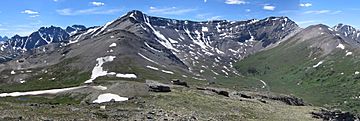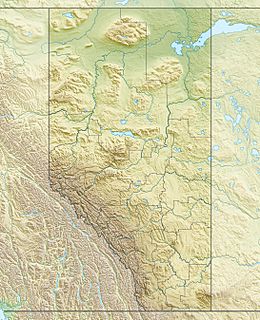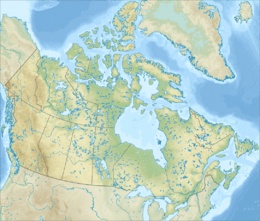Indian Ridge (Alberta) facts for kids
Quick facts for kids Indian Ridge |
|
|---|---|

Indian Ridge seen from The Whistlers.
|
|
| Highest point | |
| Elevation | 2,820 m (9,250 ft) |
| Prominence | 410 m (1,350 ft) |
| Parent peak | Manx Peak (3044 m) |
| Listing | Mountains of Alberta |
| Geography | |
| Location | Jasper National Park Alberta, Canada |
| Parent range | Trident Range Canadian Rockies |
| Topo map | NTS 83D/16 |
| Climbing | |
| Easiest route | Easy Scramble |
Indian Ridge is a tall mountain located in Jasper National Park, Alberta, Canada. It stands about 2,820 meters (9,252 feet) high. This mountain is part of the Canadian Rockies and belongs to the Trident Range.
Sometimes, people unofficially call its highest point "Indian Peak." The popular town of Jasper is about 9 kilometers (5.6 miles) away to the north-northeast. Another nearby mountain, The Whistlers, is just 2.55 kilometers (1.58 miles) to the northeast.
Indian Ridge is made of very old rocks. These rocks were formed over millions of years, from the Precambrian to the Jurassic periods. They were later pushed up and over younger rocks during a big mountain-building event called the Laramide orogeny.
Contents
Discovering Indian Ridge
How the Mountain Got Its Name
The name "Indian Ridge" was given to the peak in 1916. A man named Morrison P. Bridgland chose the name. He noticed the mountain's rocks had a reddish color.
Who Was Morrison P. Bridgland?
Morrison P. Bridgland (1878–1948) was a Dominion Land Surveyor. This means he was a government surveyor who mapped out land. He named many mountains in Jasper National Park and other parts of the Canadian Rockies. The mountain's name became official in 1951. This was decided by the Geographical Names Board of Canada.
Mountain Weather
Climate of Indian Ridge
Indian Ridge has a subarctic climate. This type of climate means the winters are very cold and snowy. Summers, however, are usually mild. Temperatures can drop below -20 degrees Celsius (-4 degrees Fahrenheit). With the wind chill, it can feel even colder, sometimes below -30 degrees Celsius (-22 degrees Fahrenheit).
Water Flow from the Mountain
Rain and melting snow from Indian Ridge flow into nearby rivers. This water eventually reaches the Miette River and the Athabasca River. These rivers are important parts of the park's natural environment.



